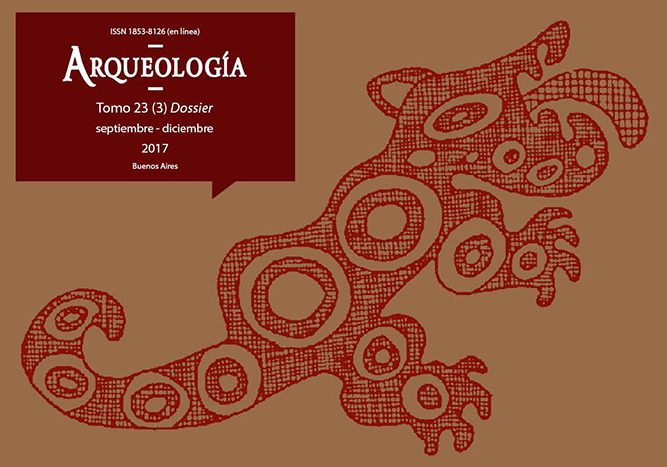El registro arqueofaunístico del subtramo Norte de la margen izquierda del Paraná Medio (Corrientes, Argentina)
Palabras clave:
Cazadores-recolectores-pescadores, Llanura aluvial del río Paraná, Holoceno tardío
Resumen
En este trabajo se integran los datos obtenidos a partir del análisis macroscópico del material faunístico recuperado en posición estratigráfica en cinco sitios emplazados en la llanura aluvial del Paraná Medio (Corrientes, Argentina). El mismo constituye una síntesis de lo realizado hasta el momento sobre esta ergología para los sitios estudiados. En esta instancia el objetivo del análisis fue generar información respecto de los procesos involucrados en la formación de los depósitos estudiados y las evidencias concretas de la acción antrópica en su composición, así como también evaluar la variabilidad del registro arqueofaunístico depositado a lo largo del bloque espacio-tiempo bajo estudio. Los resultados obtenidos permiten sostener que los agentes físicos y químicos asociados a la dinámica de un ambiente marcadamente hidrófilo limitaron en gran parte las observaciones y líneas de análisis que se pueden desarrollar. A pesar de esto, las evidencias de acción antrópica permiten sostener el origen cultural de los conjuntos estudiados. Estas dan cuenta de la explotación y procesamiento de animales acuáticos junto a ciertas especies terrestres con algún grado de dependencia del medio acuático propias de este ambiente; taxa que presentan poco riesgo de obtención dada su profusión, diversidad y presencia respecto al ciclo ecológico. La información así generada permitió considerar el área trabajada a la luz de los modelos propuestos para interpretar el registro arqueológico del Paraná Medio.Descargas
La descarga de datos todavía no está disponible.
Cómo citar
Píccoli, C. V., Martín, M. D., & Barboza, M. C. (1). El registro arqueofaunístico del subtramo Norte de la margen izquierda del Paraná Medio (Corrientes, Argentina). Arqueología, 23(3), 35-63. Recuperado a partir de http://revistascientificas.filo.uba.ar/index.php/Arqueologia/article/view/4007
Sección
Artículos
Los autores/as que publiquen en esta revista aceptan las siguientes condiciones:
- Los autores/as conservan los derechos de autor y ceden a la revista el derecho de la primera publicación, con el trabajo registrado mediante Licencia Creative Commons 4.0 Internacional (CC-BY-NC-SA), que permite a terceros utilizar lo publicado siempre que mencionen la autoría del trabajo y a la primera publicación en esta revista.
- Los autores/as pueden realizar otros acuerdos contractuales independientes y adicionales para la distribución no exclusiva de la versión del artículo publicado en esta revista (p.e. incluirlo en un repositorio institucional o publicarlo en un libro) siempre que indiquen claramente que el trabajo se publicó por primera vez en esta revista.
- Se permite y recomienda a los autores/as a publicar su trabajo en Internet (p.e. en sus sitios web personales o en depósitos institucionales), tanto antes como después de su publicación en esta revista, siempre y cuando proporcionen información bibliográfica que acredite, si procede, su publicación en ella. De esta manera, pueden favorecerse intercambios productivos y a una mayor y más rápida difusión del trabajo publicado (vea The Effect of Open Access).



.png)

(1)13.png)






1.jpg)
1.png)
1.jpg)


13.png)
1.png)


(1)1.png)









